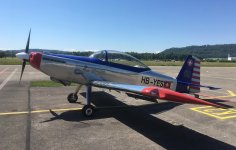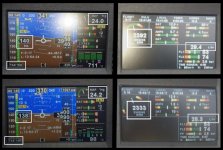I should clarify a point. I was specifically referring to UL's newer 6 cylinder, turbo charged engine.
While UL wouldn't be a market disruptor, from a price point they are positioned to at least advance their share, IMO.
The turbo version UL520T is not that new, Jan 2021, been out almost 3.5 years. Turbo charging is not a panacea for goodness. Lycoming can be and has been turbo charged for what 80 yrs. Not new. The UL520T at the core from what I know is a UL520. Will Turbo fix any Cons? Rated HP now 2700 RPM? Exasperate any weaknesses? I don't know. I would find out before buying. As I sadly mention a twin engine, canard pusher Velocity with two UL520T's* lost power on take off.
* I HAVE NO IDEA if both engines failed (lost thrust), one lost power for a reason or reasons? Not enough power to maintain altitude. Were the props feathering? Do they make electric feathering props. I don't know. I know it was UL Powered just not sure if turbo version. From what I read it was the UL520T.
What do you mean
"market disruptor". The google definition: "In business theory, disruption is considered
any innovation that creates a new market where an existing market-leading product or service is eventually displaced." OK so are we talking the latest LYCOMING KILLER.... That ia a hard no in my humble opinion.
All the limitations of a small engine company UL Power vs Lycoming, apples and apples I don't see UL Power displacing Lycoming. Let's fly Lyc vs UL power planes side by side. Let's look at real cost, reliability, factory support. Let's see what happens. If UL Power is a disruptor I will be in-line to buy one. I don't honestly see that happening.
People line up to buy UL Power en masss, fly them, they become the next "Lycoming killer" great. I have heard this for 30 yrs engine after engine. Seems they come and go. UL Power may grow to become ROTAX killer (sub 135 HP engines) and dominate the 200-220 HP market? I doubt it, but we shall see. If it happens it will take decades and likely new engine designs. Both Rotax (Bombardier) and Lycoming (Textron/Avco) are large global companies.
I see the UL520T claimed spec of 220 hp @ 2700 rpm up to 15000 ft . That is great. I recommend my fellow RV'ers not accept any claim unless verified by 3rd party with real measured data. Specs are easy to write... actual performance installed in a plane is another. There are few UL520T's flying around. I know of one. I was told (by former UL Power USA distributor) an RV-4 has a UL520T, but I was never able to verify or get performance.
The only eyes on gauges I found, was the YT video of RV-7 from Belgium I posted above, and it is the non turbo version. If UL Power was winning RENO and Aerobatic competitions (oh not aerobatic scratch that) you would hear about it. The performance of this UL Power RV-7 is not shabby, but "market disruptor" not likely with cost as much as a Lyc 180HP Lyc and less performance. I am sure an IO360 or IO390 wide open would eat this RV-7's lunch. Of course it would eat fuel. I don't think UL Powered RV's are going to win races, even the turbo version. BUT LET'S SEE. Again you can turbocharge your lawnmower, but would you? Just because you can does not mean you should. If you put around below 9,000 ft most of the time a Turbo not needed, just have more cubic inches and normally asperated. Saves a lot of STUFF with a Turbo.
Turbo does NOT add power unless you BOOST over ambient air pressure. That has been done before, cars all the time, but those are water cooled. TURBO creates HEAT and can be done on air cooled engines. However things like INTER-COOLER and bigger oil coolers are needed. With some structural issues of UL520 already experienced by SOME owners, that turbo is not going to help, unless they beefed it up. That should reflect in the weight. I am sure they engineered it... However trust but verify. If they are really making 220HP at 2700 RPM with 320 cu-in displacement they are running BOOST... That is more strain on engine and heat. Is it doable? Sure. Is it done properly? Don't know.
The most COMMON kind of turbo charging for aircraft is called NORMALIZING. This allows the engine to make the same HP at sea level (more dense air) to some critical altitude, typically 8000 feet or higher before HP starts to drop off, for example. This is great for efficiency and not has harsh on the engine. However be a benifit you need to fly at 5 digit altitudes, teens. The core a UL520T, claimed 220hp at 2700 rpm on 320 cu-in is hard to do without boost. There is no new technology here.... How did they do it? Well unless we have some flying examples showing they are making 220HP at 15,000 feet at 2,700 RPM, I am skeptical. But if they are creative and pulled it off it may take some sales from Lycoming. It is possible. 3.5 years have not seen much about the engine.
BTW they advertise FADEC. That is "modern". Not really full FADEC, it does not control the prop. FADEC came from the JET ENGINE world. So it's kind of a misnomer to use it for a piston engines, but we digress. On a $1,200,000 Cirrus SR22T you can get SINGLE lever FADEC with the TSIO550 Continental making 360 HP twin turbo intercooled engines. I hear some people like the non single lever traditional engine control version better. Cirrus is reported to not be impressed with FADEC. Is it needed and provide benefit for the cost premium and complication. Real men fly planes with 3 knobs (Black Blue Red). Ha ha. Same with turbo.... do you need to..... wait joke there but I'll stop....
UL power like ROTAX has turbo, electronic fuel and ignition as well. Not new to small engine market either.
The UL520T, turbo charging does not change physics of engine. A Lyc can be outfitted with Electronic Ignition, Electronic Fuel Injection and turbo.
ROTAX has been in business since 1920. ROTAX was bought by global behemoth Bombardier Recreational Products (BRP). ROTAX engines are in all kinds of things, motorcycles, sport watercraft and LSA's. In 70's thru the 90's they made two-stroke engines that were popular in the ultralight community. Then ROTAX came out with four-stroke, four-cylinder, engine 912, in 1989. It was slow at first, but LSA category of planes entered the USA and World, and ROTAX 912 gained a good reputation, it is the de facto 100hp-ish HP engine for the LSA market. UL POWER also also started with small sub 100HP engines in 2006, and their 4 cyl engines go head to head with ROTAX, except as air cooled direct drive configurations. In 2013 only 10 yrs ago they came out with th higher HP 6 cyl versions. The turbo versions as I said is Jan 2021, 3 yrs.
ROTAX is a market leader in KitFox,
Zenith Zenair , LSA's including RV-12. Van made the RV-12 around a ROTAX.... Just like Van made the rest of the RV line of aircraft around Lycoming. Van is no dummy. He said best engine conversion was "take $22,000 and convert it to a Lycoming. (Quote pre inflation).
Bottom line UL Power has to create something so NEW, a quantum leap or at least an evolution, that builds a reputation of innovation, value, reliability, performance, and manufacture support, to be a "market disruptor". They have a lot of work to do. I don't see it happing in the sub 130hp LSA engine market that ROTAX dominates at this time. I don't see that in the 160-360HP market.
Not that UL power is bad, but it is just the competition is good in those markets. This kills the market disrupter at least with current products. The good part for us, we have choices. These are opinions. Based on experience and physics, before I plop down $35,000 on an engine that my life depends on, it better be as a sure thing, as it can be, and a good value. UL Power is a bit of an unknown even after being in business of making UL520 of 10 years. Price wise not giving them away. Pre world wide "panorama" (joke) and supply chain Lycs were in the low $20K range. So that is a no for me on UL Power. I will be watching and hope to see one fly up close in an RV...
1929 Lycoming 1st successful radial aircraft engines, almost 100 years, 1955 first of current Horz opposed design, 70 yrs. Still Market Leader
1920, Rotax founded, first engines 1975 small 2-stroke , 50 years.... 1989, Rotax 912 first of current designs, 35 yrs. Market leader.
Who knows 18 yrs old, in 50 yrs UL Power my be a market disruptor. What market who knows they have feet in both Rotax and Lycoming markets. 




